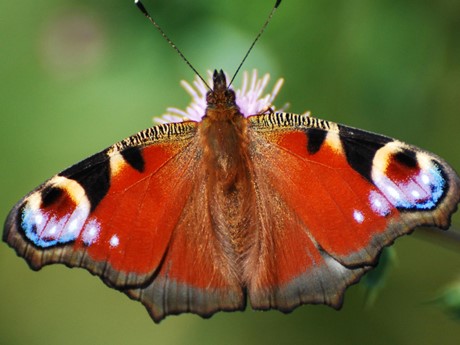Ivy: let us know when you spot this late summer flower!
Alex Marshall, 12/08/2025
August marks the start of the recording season for our only late summer flower at Nature’s Calendar. Here’s how to record the first flowering date and the amount of fruit for ivy, and a look back at previous records.
What to look for
On an ivy plant that you can visit regularly (ideally once a week), record first flowering date when the petals have opened sufficiently for you to see inside the flower. See the photo collage below for an example.
Expected Date Range: August to late October
Ivy leaves are dark green and glossy with pale veins. Juvenile leaves have 3-5 lobes and a pale underside. Mature leaves are oval or heart-shaped without lobes. Common ivy has leaves with 3-5 lobes, while Atlantic ivy has leaves with 5-7 lobes.
Only mature plants produce flowers. Each flower has five petals, are yellowish green and appear in small, dome-shaped clusters known as umbels. Flowers of common ivy are typically larger, more rounded and with a more pronounced green tinge than those of Atlantic ivy.

Credit: Ben Lee WTML
Left: (too early to record), the top and bottom image show flower buds which have not opened enough to see inside the flower.
Centre: (just right to record), there are several open flowers on the flowerhead as seen by the yellow anthers. It is at this point that you should record the ‘first flowering’ date for Nature’s Calendar!
Right: (too late to record), the top image shows the flowerhead covered in open flowers, suggesting this is not the ‘first’ date for the flowers to have opened, and below that, the darker colouration shows that flowerhead has turned to seed, and has surpassed its flowering time.
What do previous Nature’s Calendar records show?
Last year, 2024, saw the earliest average first flowering date for ivy in the UK, on 15 September, since it started being recorded in 1999.
This may have been due to the slightly above average UK temperatures in August 2024.
This was two weeks earlier than in 2001 when the UK average was 1 October, which was the latest average date in the series. The 24-year average first flowering date is 22 September.
Recording the amount of fruit

Credit: Ben Lee WTML
This is a subjective assessment of fruit crop. Give the plant you record a fruit score from 1 to 5 using the scale below. Only record amount of fruit on untrimmed plants.
If you are not used to looking at the amount of fruit, don’t record this until you feel confident to do so. It may take a couple of years of observing a plant to get an idea of what is a ‘good’ or ‘meagre’ crop compared to previous years.
If you have recorded ivy events before, continue to record on the same plant.
1 = no fruit
2 = meagre
3 = moderate
4 = good
5 = exceptional
Why do we record amount of fruit?
This is an indicator of winter food availability for birds and mammals, as well as the seed source available for natural regeneration of trees and shrubs, and may be linked to climate variables in preceding seasons.
Our dataset for ivy amount of fruit begins in 2000. In 2014, we had our highest ivy fruit score of 4.3 out of 5. Last year’s fruit score was 4.2, and the average over the past 24 years is 4.1.
The fruit score for ivy doesn’t vary much from year to year, the lowest fruit score recorded was 3.9 in 2012, only 0.4 lower than the highest score in 2014. This contrasts with other species such as oak and beech, which have had fruit scores ranging from 1.9 to 4.1 and 2.2 to 4.3, respectively.
Each year we produce seasonal reports using the data you send us – you can freely download them from our website.
How will this year compare? The only way we will know is if you let us know what’s happening with the ivy near you!
